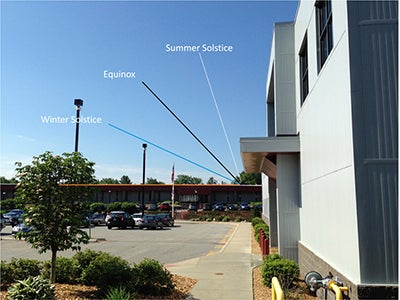Tech Tips
Avoid Failure of South-Facing Window Graphics in Winter

It’s no secret that the successful installation of window graphics in cold weather brings its share of challenges. At temperatures below 50°F, bonding of the adhesive to the glass takes longer than at warmer temperatures, and, if a wet application method is used, it also takes longer for the moisture to evaporate from beneath the graphic, further increasing the bonding time. This can lead to problems, from hazing in the adhesive caused by the retained moisture, to delamination of the substrate from the glass surface.
A winter challenge to consider.
When it comes to windows that face the south in the northern hemisphere, however, there is an even bigger challenge to consider. During winter, the sun remains low in the sky, with its light shining more directly on south-facing windows for longer periods of time than in summer. This allows for a unique situation where applied graphics, most notably dark colored graphics, can absorb the heat of the sun more dramatically than at other times of the year. This is especially problematic in the morning when air and glass temperatures are at the coldest of the day. Dramatic temperature differentials across the face of the glass can be generated on bright cold mornings depending on the color of the graphics. Furthermore, since graphics are typically installed in the evening after stores close, the temperature differential from morning to afternoon is much greater (roughly -10°F to 50°F sunup to sundown in winter vs. 60°F to 90°F in summer). That’s a difference of 60°F vs. 30°F — twice the change.
What to know about "thermal absorption".
If there are large areas of dark colors in the graphic, this effect is magnified because they absorb more light and heat than lighter colors, causing them to rise to significantly higher temperatures. Think of the seats you wouldn’t want to sit on wearing shorts on a hot summer day. The heat causes the glass in the areas with dark graphics to expand — referred to as “thermal absorption” — which can cause piping and peeling of the graphic in those areas. If the graphic gets hot enough, it can even cause the glass to crack. A complaint arising from such issues is quite often assumed to be a printing or installation issue; however, it’s much more likely that large areas of dark colors are to blame. This is especially true if those areas are located at the bottom of the window where it gets virtually no shade. This is seen most often with dark red, purple, blue and black.
The stress created by the temperature differential can cause the glass to crack. This generally occurs in and around pre-existing small imperfections in the glass. In other cases, the expansion of the glass within a tight-fitting frame can cause a fracture to initiate at a contact point in the frame. The colder the climate, the more of an issue this becomes, so geographic locations with the harshest winters are at the greatest risk.
Above is a series of images of a black graphic on glass in New England in March taken with a thermal imaging camera. In less than 20 minutes, the temperature of the glass where the black material is located goes from 49.3°F to 74°F! The differential from the center of the black graphic to the cold periphery is nearly 30°F.
What can be done?
Minimizing that risk is simple. While you can’t control where your customers’ windows are located, you can guide them in the creation of their artwork. Be sure to ask what direction their windows face and urge them to stick to lighter colors for their south-facing window graphics (or north-facing if they are located in the southern hemisphere). Suggest that they save the darker colors for other times of the year. It’s not a guarantee, but it will surely limit the chance of application failure.